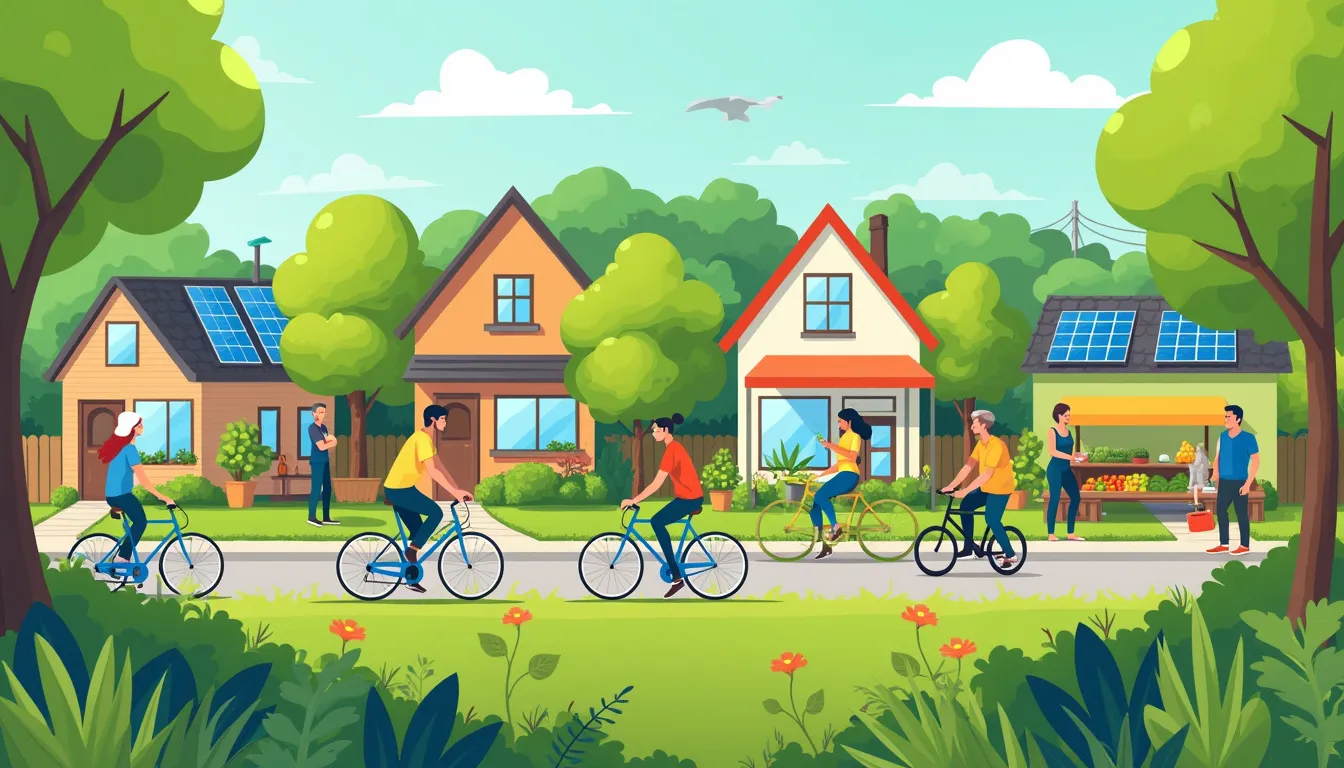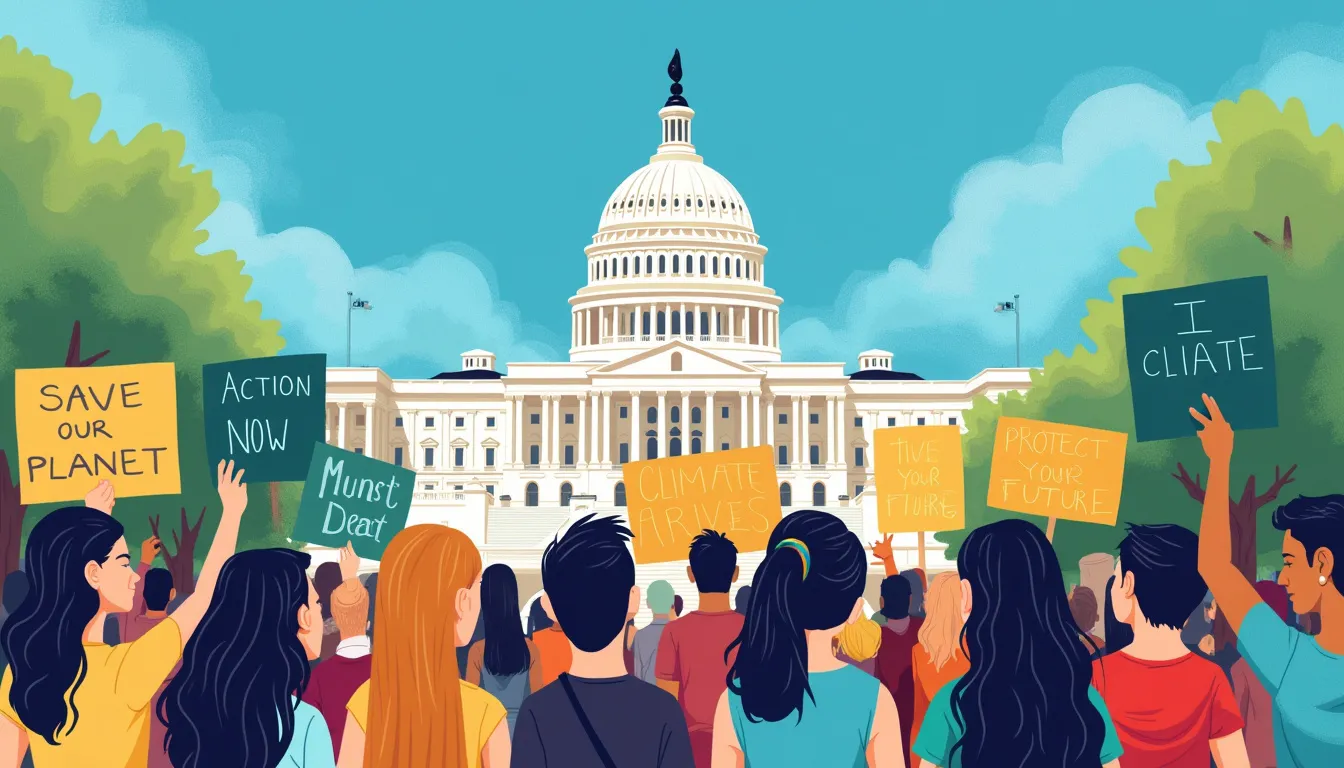Every day, our planet sends us distress signals – from devastating wildfires and intense hurricanes to unprecedented heatwaves and melting ice caps. These are not just isolated incidents but symptoms of a larger, more pervasive issue: climate change. The urgency to address climate action has never been more apparent. In fact, the Intergovernmental Panel on Climate Change (IPCC) warns that we have less than a decade to make significant changes to avoid the most catastrophic impacts of global warming. This isn’t just about preserving the environment for future generations; it’s about immediate survival and well-being.
The current climate crisis is a complex challenge, yet it offers a unique opportunity for transformative change. Rising global temperatures, increased greenhouse gas emissions, and rampant deforestation are driving the climate into uncharted and dangerous territory. The effects are felt worldwide, impacting ecosystems, human health, and economies alike. However, immediate and effective climate actions can mitigate long-term damage and set us on a path toward a more sustainable and resilient future.
Urgent steps for effective climate action involve a multi-faceted approach that includes transitioning to renewable energy, promoting sustainable practices, and advocating for strong governmental policies. Each action reinforces the other, creating a comprehensive strategy that not only addresses the roots of climate change but also empowers communities and businesses to adopt greener initiatives. Through collaborative efforts and innovative solutions, we can tackle this crisis head-on and pave the way for a healthier planet. So let’s delve into the steps we can take to make a meaningful impact and embrace the promise of a sustainable world.
Introduction to Climate Action
The Importance of Addressing Climate Change
Climate change isn’t a distant problem for future generations to address—it’s here and now. From record-breaking temperatures to increasingly frequent natural disasters, the effects of climate change are evident across the globe. In fact, a study published in Nature Climate Change established that over 70% of extreme weather events today are exacerbated by climate change. Addressing this issue isn’t merely an option; it’s an urgent necessity for safeguarding the planet and its inhabitants.
Overview of the Current Climate Crisis
The current state of our climate is alarming. Global temperatures have risen by approximately 1.2 degrees Celsius since the pre-industrial era, according to the Intergovernmental Panel on Climate Change (IPCC). While this might seem like a small number, it has far-reaching consequences. The melting of polar ice caps, rising sea levels, and disrupted weather patterns are all part of this complex crisis. Furthermore, the World Health Organization (WHO) notes that climate change is expected to cause around 250,000 additional deaths per year between 2030 and 2050, stemming from malnutrition, malaria, diarrhea, and heat stress.
These statistics underscore the dire need for effective climate action. As natural systems reach their tipping points, the window for reversing damage narrows. Addressing climate change through meaningful actions can not only help stabilize the environment but also provide economic and social benefits.
How Immediate Actions Can Mitigate Long-Term Damage
Effective climate action requires immediate steps at both individual and collective levels. One inspiring example is the city of Copenhagen, which has implemented a comprehensive plan to become carbon-neutral by 2025. Their strategies include widespread use of bicycles, renewable energy projects, and green building standards. This is not just a lofty goal; it’s an example of how immediate, bold actions can set the stage for a sustainable future.
To delve deeper, consider the role of individuals. Everyday choices, from reducing plastic consumption to supporting eco-friendly companies, cumulatively contribute to a larger impact. Imagine the ripple effect if more people subscribed to renewable energy through their utility companies. According to the International Energy Agency (IEA), a 10% increase in renewable energy adoption across households can reduce millions of tons of carbon emissions annually.
Therefore, implementing immediate climate actions is not just beneficial but crucial for mitigating long-term damage. Momentum is built through cumulative efforts, creating a future that is not only sustainable but also resilient. In the subsequent sections, we’ll explore practical and impactful steps that both individuals and businesses can take to join this global movement for climate action.

Implementing Renewable Energy Solutions
Benefits of Transitioning to Renewable Energy Sources
Switching to renewable energy sources is like planting a tree that not only provides shade but also cleans the air. Renewable energy solutions play a significant role in effective climate action by reducing greenhouse gas emissions, improving public health, and promoting energy security. Unlike fossil fuels, renewable energy sources like solar, wind, and hydro produce no direct emissions, making them a clean alternative.
One of the primary benefits of renewable energy is its potential to mitigate climate change. Fossil fuel combustion is a leading cause of carbon dioxide (CO2) emissions, which contribute to global warming. By transitioning to renewable energy, we can significantly reduce this carbon footprint. According to a study by the International Renewable Energy Agency (IRENA), renewable energy could contribute to reducing up to 70% of global CO2 emissions by 2050.
Aside from environmental benefits, renewable energy also promotes economic growth by creating jobs. For example, the solar industry alone employs over 240,000 workers in the United States, surpassing those employed in the coal industry. This not only fosters economic resilience but also encourages technological innovation and investment in cleaner infrastructure.
Examples of Renewable Energy Solutions
Renewable energy comes in various forms, each with unique benefits and applications. Here are some of the most impactful solutions:
Solar Energy
Solar energy harnesses power from the sun through photovoltaic (PV) panels or solar thermal systems. It is one of the fastest-growing renewable energy technologies and can be used in residential, commercial, and industrial settings. A household with a rooftop solar panel can save up to $20,000 in electricity bills over 20 years. Additionally, community solar projects allow multiple users to benefit from a single solar array, making clean energy more accessible.
Wind Energy
Wind energy captures kinetic energy from wind using turbines to generate electricity. Wind farms can be onshore or offshore, with offshore wind farms generally having higher efficiency due to stronger and more consistent wind patterns. Denmark, for instance, derives nearly half of its electricity from wind power, showcasing the technology’s viability. On a smaller scale, wind turbines can also be used for local energy production in rural or remote areas.
Hydroelectric Power
Hydroelectric power generates electricity by using flowing water to spin a turbine connected to a generator. It is one of the oldest and most established forms of renewable energy, accounting for about 16% of the world’s electricity. Large-scale hydroelectric projects, like Brazil’s Itaipu Dam, provide substantial power to national grids, while small-scale hydro systems can power local communities and even individual homes.
Steps to Encourage Widespread Adoption of Renewable Energy
Achieving widespread adoption of renewable energy requires collective efforts from individuals, businesses, and governments. Here are some practical steps to consider:
Incentivizing Adoption
Governments can play a pivotal role by offering financial incentives, such as tax credits, rebates, and grants for renewable energy projects. For example, the U.S. federal Investment Tax Credit (ITC) provides a 26% tax credit for solar systems on residential and commercial properties, making it more affordable for homeowners and businesses to go solar.
Implementing Policy Measures
Strong policy frameworks are crucial for the long-term growth of renewable energy. Renewable Portfolio Standards (RPS) that mandate a certain percentage of energy from renewable sources can drive significant investments. Countries like Germany have implemented policies like the Renewable Energy Act (EEG) to boost renewable energy production, leading Germany to become a global leader in solar and wind energy.
Educating and Raising Awareness
Public awareness campaigns and educational programs can also drive the adoption of renewable energy. Informing consumers about the benefits of renewable energy and providing practical information about installation and maintenance can demystify the process. Community workshops, online resources, and partnerships with local organizations can amplify these efforts.
Investing in Infrastructure
Investment in modernizing and expanding grid infrastructure is essential. Adequate grid capacity and smart grid technologies can better manage the variability of renewable energy sources. Similarly, investing in energy storage solutions like batteries can help balance supply and demand, ensuring a stable energy supply even when the sun isn’t shining or the wind isn’t blowing.
Supporting Innovation and Research
Continuous research and development are key to advancing renewable energy technologies. Governments and private sectors should support innovative projects that enhance the efficiency and affordability of renewable technologies. Breakthroughs in areas such as solar cell efficiency, wind turbine design, and battery storage can unlock new potentials for clean energy.
Transitioning to renewable energy is not merely an aspiration but a tangible and necessary step for effective climate action. By understanding and leveraging the benefits, exploring diverse renewable solutions, and taking concrete steps to promote their adoption, we can pave the way for a sustainable future that benefits both the planet and its inhabitants.

Promoting Sustainable Practices
When it comes to climate action, every action counts. By integrating sustainable practices into our daily lives, we can significantly contribute to reducing carbon footprints and preserving the environment. Here we delve into some impactful ways to promote sustainability through lifestyle changes, agriculture, and transportation, and how businesses and communities can embrace these practices.
Reducing Carbon Footprints Through Lifestyle Changes
Small adjustments in our everyday choices can accumulate to make a substantial difference. Consider this: if each household in the United States reduced their energy consumption by just 10%, the collective impact would be monumental. Here are some realistic and effective ways to minimize our carbon footprint:
- Energy Efficiency: Opt for energy-efficient appliances and lighting. Switch to LED bulbs, which use up to 85% less energy than traditional incandescent bulbs.
- Reduce, Reuse, Recycle: Practicing the three Rs can help decrease waste and save resources. According to the Environmental Protection Agency (EPA), recycling just one ton of paper can save 17 trees and over 3 cubic yards of landfill space.
- Sustainable Fashion: Fast fashion is a significant contributor to environmental degradation. Support brands that prioritize sustainable practices, or consider buying second-hand and upcycled clothing.
A personal story: I began swapping out single-use plastic for reusable alternatives, like metal straws and cloth shopping bags. These small changes not only lower waste but also inspire friends and family to adopt similar practices.
Importance of Sustainable Agriculture and Transportation
Agriculture and transportation are two critical sectors where sustainable practices can lead to major reductions in greenhouse gas emissions.
Sustainable Agriculture
Sustainable agriculture involves methods that protect the environment, public health, human communities, and animal welfare. Some effective practices include:
- Organic Farming: By eliminating the use of synthetic pesticides and fertilizers, organic farming minimizes harmful chemical runoff and supports soil health.
- Agroforestry: This practice integrates trees and shrubs into farming landscapes, increasing biodiversity, improving water retention, and storing carbon.
- Crop Rotation and Polyculture: These techniques help maintain soil fertility, reduce pest pressures, and improve crop resilience.
Take, for instance, the success story of Gabe Brown, a pioneer of regenerative agriculture. By adopting no-till farming, cover cropping, and holistic management, Brown revitalized his farmland, improved soil health, and significantly increased his yield without relying on synthetic inputs.
Sustainable Transportation
Transportation accounts for nearly 25% of global CO2 emissions. Shifting to more sustainable transport options can drastically cut these emissions:
- Public Transit and Cycling: Opting for public transportation, biking, or walking reduces traffic congestion and pollution. Cities like Copenhagen and Amsterdam are leading the way with bike-friendly infrastructure that makes cycling a preferred mode of travel.
- Electric Vehicles (EVs): With advancements in technology and a growing network of charging stations, EVs are becoming viable alternatives to traditional combustion-engine vehicles. Tesla, Nissan, and many other companies are making strides in this area.
- Carpooling and Ride-Sharing: Services like UberPOOL and Lyft Line, or even traditional carpooling, can significantly lower the number of vehicles on the road.
Personally, I switched to using an electric scooter for short commutes. It’s not only eco-friendly but also a fun way to get around. Small changes like these, when adopted widely, can lead to a more sustainable transportation ecosystem.
Encouraging Businesses and Communities to Adopt Sustainable Practices
For meaningful climate action, it’s essential for businesses and communities to lead by example. Here are some effective strategies to promote sustainability:
Businesses
Companies of all sizes can implement sustainable practices that benefit both the environment and their bottom line. Consider the following:
- Going Green in Operations: Implementing energy-saving measures, reducing waste, and optimizing resource use can significantly lower a company’s carbon footprint. For instance, Google’s renewable energy investments have enabled it to achieve carbon neutrality since 2007.
- Sustainable Product Design: By designing products with sustainability in mind, businesses can reduce material use and waste. Patagonia, known for its durable and environmentally friendly products, is a prime example of this approach.
- Employee Engagement: Encouraging employees to adopt sustainable practices, both in the workplace and at home, can have a significant ripple effect. Initiatives like carpool programs, remote work options, and office recycling schemes are useful starting points.
Communities
Community engagement is crucial for fostering a culture of sustainability. Here are some ways to encourage collective action:
- Local Initiatives: Communities can organize clean-up drives, tree-planting events, and sustainability workshops. These activities not only improve the environment but also strengthen community bonds.
- Supporting Local Businesses: Buying local reduces transportation emissions, supports the local economy, and often ensures better product traceability. Farmers’ markets and local artisans are great starting points.
- Advocacy and Education: Educating community members about sustainability through campaigns and outreach programs can empower individuals to take meaningful action. Programs like Transition Towns, which focus on creating sustainable local communities, have seen tremendous success globally.
Reflecting on my community’s efforts, I recall organizing a neighborhood clean-up event that not only cleared litter but also inspired residents to be more mindful of waste disposal. Such communal actions reinforce the importance and impact of collective responsibility.

Policy and Advocacy for Climate Action
When it comes to climate action, government policies play a crucial role in setting the framework and laying down the rules for sustainable practices. Policies can significantly influence how industries operate, what products are available to consumers, and even the kinds of energy that power our homes. For instance, policies like carbon pricing or renewable energy incentives can encourage businesses to reduce their carbon emissions and invest in cleaner technologies. Additionally, policies focusing on public transportation and sustainable agriculture can create a chain reaction of positive environmental impacts, leading to a more sustainable future.
How Government Policies Drive Climate Action
Government policies have the potential to drive large-scale climate action in a way that individual efforts, while important, simply cannot match. Comprehensive regulations can standardize practices across entire sectors, ensuring that environmental responsibility becomes a norm rather than an option. For example, the Clean Air Act in the United States has been instrumental in reducing air pollution since its inception. Policies that mandate renewable energy quotas or provide subsidies for green technologies can also stimulate innovation and lower costs, making sustainable solutions more accessible to the public.
How Individuals Can Influence Policy Changes Through Advocacy
You might wonder how you, as an individual, can have a role in influencing these large-scale policies. The answer lies in advocacy. By raising your voice, joining community groups, and participating in local government meetings, you can make a difference. Advocacy can take many forms, from signing petitions and contacting your elected officials to participating in peaceful protests and social media campaigns. Your advocacy can encourage policymakers to prioritize climate action and implement the changes necessary to combat the climate crisis.
Take the story of the young environmental activist Greta Thunberg, who started by sitting alone outside the Swedish parliament with a sign that read, School Strike for Climate. Her solitary protest grew into a global movement, with millions of students around the world joining her cause. This massive wave of youth activism has successfully pressured governments to take more concrete steps towards combating climate change.
Successful Case Studies of Policy-Driven Climate Initiatives
There’s no shortage of examples that underscore the power of policy-driven initiatives in achieving substantial climate action. One of the most cited success stories is that of Denmark. The Danish government has implemented policies that promote wind energy, making Denmark one of the world leaders in wind power. With the right incentives and investments, the country has dramatically reduced its reliance on fossil fuels and is well on its way to achieving its goal of becoming carbon neutral by 2050.
Another excellent case is the introduction of the carbon pricing mechanism in British Columbia, Canada. This policy was designed to encourage businesses and consumers to opt for greener alternatives by taxing carbon emissions. In the years following its implementation, British Columbia has not only reduced its greenhouse gas emissions but also experienced economic growth, debunking the myth that environmental regulations stifle economic development.
On a smaller scale, the city of Portland, Oregon, has shown how local government initiatives can lead to significant changes. Portland’s comprehensive climate action plan includes measures to reduce greenhouse gas emissions, improve public transportation, and enhance energy efficiency. These efforts have led to substantial reductions in carbon emissions and have positioned the city as a leader in urban sustainability.
But it’s not just on the international or national stage where policies can make a difference. Local policy changes, such as implementing bike lanes, creating more green spaces, and enforcing recycling mandates, all contribute to a greater cause. The city of Curitiba in Brazil offers an inspiring example. Through innovative urban planning and investment in public transport, Curitiba has managed to achieve remarkable results in terms of reduced traffic congestion and lower emissions. These changes improve the quality of life for residents while simultaneously promoting sustainability.
Steps to Take Action
So, what can you do to support policy and advocacy for climate action? Here are some actionable steps:
- Stay Informed: Knowledge is power. Keep up-to-date with the latest developments in climate policy and environmental news. Websites like the Environmental Protection Agency (EPA) and the Intergovernmental Panel on Climate Change (IPCC) are excellent resources.
- Vote: Exercise your democratic rights by voting for candidates who prioritize climate action in their agendas.
- Engage with Your Community: Join or form local community groups focused on environmental advocacy. Community efforts can amplify individual voices and exert collective influence on policymakers.
- Contact Your Representatives: Reach out to your elected officials to express your concerns about climate change and urge them to support sustainable policies.
- Support Environmental Organizations: Many organizations are dedicated to environmental advocacy and policy change. Support them through donations, volunteering, or amplifying their messages on social media.
By leveraging the power of policy and advocacy, we can drive the systemic changes needed for effective climate action. Working together, we can ensure a sustainable and thriving planet for future generations.
In conclusion, taking urgent steps for effective climate action cannot be overstated—our planet’s future hinges on the decisions we make today. As we’ve explored, addressing climate change starts with an understanding of its critical importance and the immediate actions that can stave off long-term environmental detriment.
Transitioning to renewable energy sources stands as a pivotal move. By embracing solar, wind, and hydro solutions, we not only diminish our reliance on fossil fuels but also contribute to a healthier planet. Simple steps, like installing solar panels, supporting wind farms, or advocating for hydroelectric projects, can collectively lead to a significant impact.
Moreover, integrating sustainable practices into our daily lives plays a key role. From reducing our carbon footprints through simple lifestyle changes, such as minimizing waste and conserving energy, to supporting sustainable agriculture and opting for eco-friendly transportation, every action counts. Businesses and communities also have a tremendous opportunity to lead by example, showing that sustainability and profitability can go hand in hand.
Equally important is the role of policy and advocacy. Government policies are crucial in setting the framework for broad-scale climate action. As individuals, our voices matter. By participating in advocacy efforts and supporting policies that promote sustainability, we can influence meaningful change. We can draw inspiration from successful policy-driven initiatives worldwide that demonstrate the powerful difference structured climate action can make.
It’s easy to feel overwhelmed by the magnitude of climate change, but it’s important to remember that every step toward sustainability counts. Whether it’s at home or in the business realm, there are numerous ways we can contribute to a healthier and more sustainable planet. By making conscious decisions and advocating for lasting change, we pave the way for a more resilient future for generations to come. Now is the time to act—because climate action isn’t just necessary; it’s urgent.
Support Us: Check out our recommended products on Amazon.

